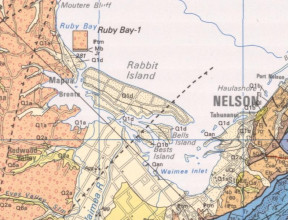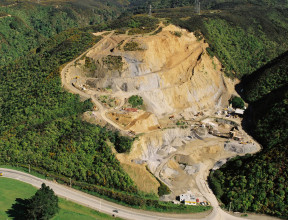
Plutons

Plutons result from the slow cooling of magma beneath the Earth’s surface.
How plutons form
Plutons result from the slow cooling of magma beneath the Earth’s surface. They cool at different levels in the Earth’s crust and may be exposed through tectonic uplift and erosion. The plutons we see at the surface today may have originally crystallised tens of kilometres deep in the crust hundreds of millions of years ago.
The gradual cooling enables minerals such as quartz, feldspar, pyroxene, amphibole and mica to grow into large crystals. The chemical composition of the magma influences which minerals form and how abundant they are:
- magma rich in silica will result in large proportions of quartz and alkali feldspar
- silica-poor magma will have limited or no plagioclase feldspar, no quartz but an abundance of dark iron, calcium and magnesium-bearing pyroxene or amphibole minerals
Plutons help with understanding magma source and emplacement history
Plutonic rocks vary considerably in terms of colour, grainsize and density, characteristics that are captured in a plethora of rock names such as granite, syenite, granodiorite, tonalite, diorite, gabbro and norite. Plutons can have considerable or very little variation in rock type. The origin of magma is instrumental in determining a pluton’s composition, and in turn, a pluton’s composition gives us clues to its origins. So, by characterising the mineralogy and geochemistry of a pluton we can understand magma source and emplacement history.
Magma generation occurs because of tectonic processes such as subduction, rifting and continental collision. The geological history of Te Riu-a-Maui / Zealandia has involved many different tectonic episodes, usually adjacent to a tectonic plate boundary, over the last 500 million years.
Plutons are one of the tangible ways to recognise the different tectonic processes that have operated. Our plutons mostly fall within two time periods.
- the earlier period spans c. 400–350 Ma and is dominated by the silica-rich, sedimentary-derived granite of northern West Coast and northwest Nelson with a significant mafic pluton intrusion accumulation around Riwaka
- the later and more productive period of pluton intrusion occurred between c. 140–100 Ma (Early Cretaceous) resulting from melts mostly generated from igneous material, some with a sedimentary component, in a long-lived subduction zone. These plutons are widespread in Rakiura / Stewart Island, Fiordland, northern West Coast and west Nelson
Plutons can have mapped areas of less than 1ha ranging up to hundreds, even thousands of square kilometres.
Plutons can be subcircular in shape, but more commonly are elongate. They can occur in isolation, having intruded into (crystallised against) sedimentary, metamorphic or volcanic rock or older plutonic rocks. Where plutonic rocks are similar in appearance, in multiple places, they can be collectively interpreted as belonging to one pluton. The interpretation is commonly refined by chemical, isotopic and physical property analysis of field samples as well as radiometric dating. Pluton boundaries can be observed in places on the ground and also through interpretation of remotely-sensed aeromagnetic, radiometric and hyperspectral data. Multiple plutons in close contact form batholiths and in the places where they have similar intrusion ages can be interpreted as the products of a major geologic thermal event.
Magma generation occurs because of tectonic processes such as subduction, rifting and continental collision. The geological history of Te Riu-a-Maui / Zealandia has involved many different tectonic episodes, usually adjacent to a tectonic plate boundary, over the last 500 million years.
The chemistry of plutonic rocks
This chemistry is typically measured in terms of the concentration of around 70 elements. Silica and aluminium are the most common elements, but valuable metals with concentrations in parts per million can be significant for economic reasons, as well as for understanding magma origins.
The geochemical analyses are stored in the PETLAB database from where they can be searched, selected and extracted for further research by anyone. The data can have a range of quality depending on when and how the samples were analysed, reflecting the precision and analytical methods available at the time. The analyses are measures of the composition of the samples and they do not necessarily approximate the average composition of the pluton. Multiple sampling of a pluton is important to establish the range of chemical variation and this helps select the sample that best represents each pluton.
How we can identify a pluton’s age
More than 70% of our plutons have modern and accurate geochronological age determinations – typically uranium–lead ages. These are derived from radioactive decay within minerals such as zircon that are normally highly resistant to resetting of their isotopic clocks after crystallising from the magma. Analysis of isotopic ratios are particularly important for understanding pluton origins and tectonic setting. These ratios can reflect the extent of sedimentary material input, the depth of magma generation and crystallisation, and in some cases a window into the history of the precursor rocks that formed billions of years ago.


